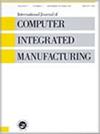GNN-based deep reinforcement learning for MBD product model recommendation
IF 3.7
3区 工程技术
Q2 COMPUTER SCIENCE, INTERDISCIPLINARY APPLICATIONS
International Journal of Computer Integrated Manufacturing
Pub Date : 2023-10-02
DOI:10.1080/0951192x.2023.2258090
引用次数: 0
Abstract
ABSTRACTDigital twin is more and more widely used, and the delivery demand of digital twin is more and more prominent at the same time of product physical delivery. Research on the digital twin product model recommendation method is of great significance for the rapid construction and reuse of digital twins. The methods currently in use, however, principally concentrate on geometric reuse and pay little attention to functional or knowledge reuse. In this paper, a graph neural network (GNN)-based deep reinforcement learning (DRL) for product model recommendation is presented. First, an MBD (model-based definition)-based semantic feature attribute adjacency graph (MSFAAG) is introduced to structured MBD model as the carrier of the digital twin product model. The MSFAAG is then embedded into continuous vector spaces using a GNN to obtain the categorization of these MBD models. Finally, DRL is used to adaptively identify more important semantic features, including manufacturing semantics and functional semantics, to obtain more detailed model classification results. The experiment effectively improves the reuse efficiency of the non-geometric aspects of the digital twin product and MBD model. Compared with other traditional recommendation algorithms, the algorithm proposed in this paper has higher accuracy and can well meet the design requirements of users.KEYWORDS: Model based definitiongraph neural networksdeep reinforcement learningreuse, recommendation AcknowledgementsThis work was supported in part by the National Natural Science Foundation of China under Grant No.61672461 and No.62073293.Disclosure statementNo potential conflict of interest was reported by the author(s).Additional informationFundingThis work was supported by the National Natural Science Foundation of China [61672461].基于gnn的MBD产品模型推荐深度强化学习
摘要数字孪生的应用越来越广泛,在产品实物交付的同时,数字孪生的交付需求也越来越突出。研究数字孪生产品模型推荐方法对数字孪生产品的快速构建和重用具有重要意义。然而,目前使用的方法主要集中在几何重用上,很少关注功能或知识的重用。本文提出了一种基于图神经网络(GNN)的产品模型推荐深度强化学习(DRL)方法。首先,将基于模型定义的语义特征属性邻接图(MSFAAG)引入结构化MBD模型,作为数字孪生产品模型的载体;然后使用GNN将MSFAAG嵌入到连续向量空间中,以获得这些MBD模型的分类。最后,利用DRL自适应识别更重要的语义特征,包括制造语义和功能语义,以获得更详细的模型分类结果。实验有效地提高了数字孪生产品和MBD模型非几何方面的复用效率。与其他传统推荐算法相比,本文提出的算法具有更高的准确率,能够很好地满足用户的设计要求。关键词:基于模型的定义;图神经网络;深度强化学习;重用;推荐。披露声明作者未报告潜在的利益冲突。本研究得到国家自然科学基金资助[61672461]。
本文章由计算机程序翻译,如有差异,请以英文原文为准。
求助全文
约1分钟内获得全文
求助全文
来源期刊
CiteScore
9.00
自引率
9.80%
发文量
73
审稿时长
10 months
期刊介绍:
International Journal of Computer Integrated Manufacturing (IJCIM) reports new research in theory and applications of computer integrated manufacturing. The scope spans mechanical and manufacturing engineering, software and computer engineering as well as automation and control engineering with a particular focus on today’s data driven manufacturing. Terms such as industry 4.0, intelligent manufacturing, digital manufacturing and cyber-physical manufacturing systems are now used to identify the area of knowledge that IJCIM has supported and shaped in its history of more than 30 years.
IJCIM continues to grow and has become a key forum for academics and industrial researchers to exchange information and ideas. In response to this interest, IJCIM is now published monthly, enabling the editors to target topical special issues; topics as diverse as digital twins, transdisciplinary engineering, cloud manufacturing, deep learning for manufacturing, service-oriented architectures, dematerialized manufacturing systems, wireless manufacturing and digital enterprise technologies to name a few.

 求助内容:
求助内容: 应助结果提醒方式:
应助结果提醒方式:


